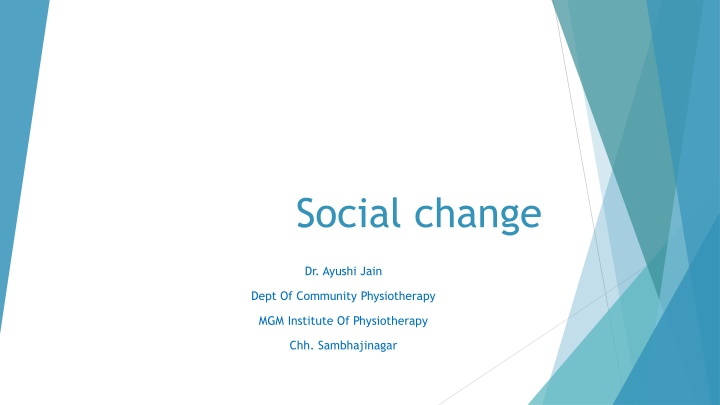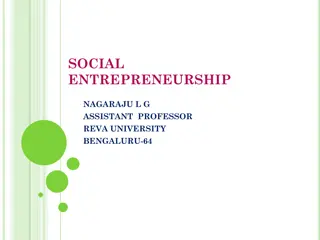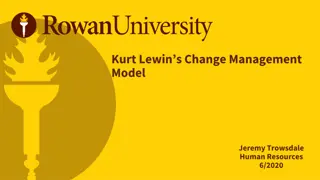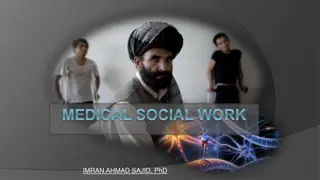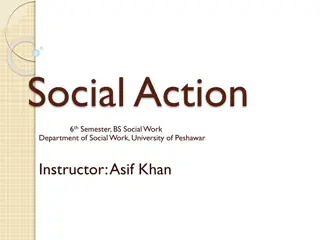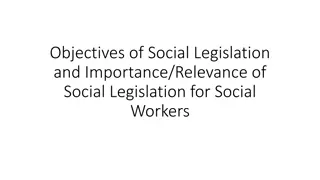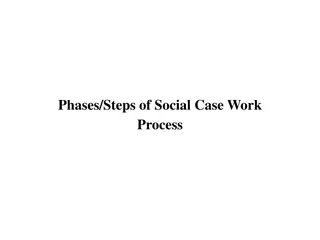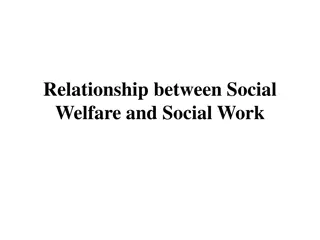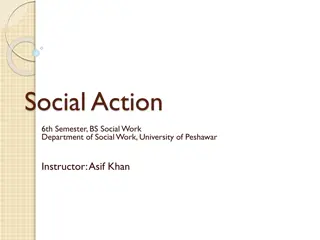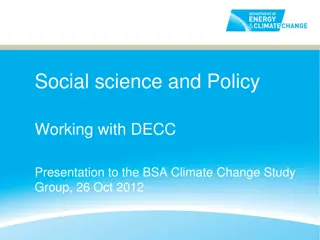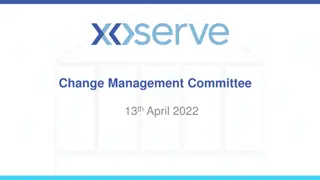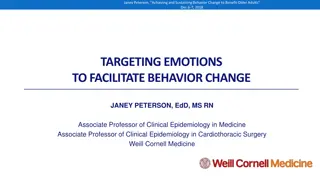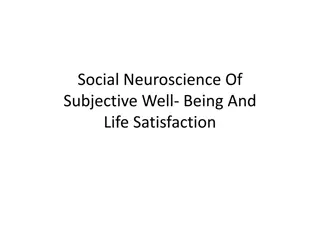Social change
Social change is a universal phenomenon encompassing variations in social processes, interactions, and organizations. It is influenced by cultural, technological, biological factors, and manifests through deviant behaviors that can lead to both disorganization and innovation within societies. Factors facilitating deviance include non-conformity, weak sanctions, poor law enforcement, and corrupt practices. Embracing and managing social change is essential for societal evolution and progress.
Download Presentation

Please find below an Image/Link to download the presentation.
The content on the website is provided AS IS for your information and personal use only. It may not be sold, licensed, or shared on other websites without obtaining consent from the author.If you encounter any issues during the download, it is possible that the publisher has removed the file from their server.
You are allowed to download the files provided on this website for personal or commercial use, subject to the condition that they are used lawfully. All files are the property of their respective owners.
The content on the website is provided AS IS for your information and personal use only. It may not be sold, licensed, or shared on other websites without obtaining consent from the author.
E N D
Presentation Transcript
Social change Dr. Ayushi Jain Dept Of Community Physiotherapy MGM Institute Of Physiotherapy Chh. Sambhajinagar
Definition - Variations in or modifications of any aspect of social processes, social patterns, social interactions or social organisations Jones ME The basic fact of today is the tremendous pace of change in human life . Jawaharlal Nehru Change refers to evolution, progress or adaptation.
Nature Universal phenomenon Community change Speed is not uniform Affected by time factor Occurs as an essential law Definite prediction is not possible Shows chain reaction sequence
Cultural Technological Biological Factors affecting social change Population Psychological Environmental
Social Deviation and Social Change Social change is a continuous phenomena, law of nature, universal phenomenon; the traditional societies also subjected to change. Continuous change in the behaviour leads to new norms. The deviance of one generation may be turning into the norm of the next. Effectiveness in the society is possible only when new norms emerge continuously, from deviance. Deviant behaviour may threaten social stability.
If deviant behaviour evades the norms, leads to disorganisation. Some times deviant behaviour enables culture to adopt certain change or violation. Eg: Cocktail functions will facilitate discrete sexual offences. To maintain social order, social control and socialisation are essential. People do not conform to all the norms always. No individual always conforms to every set of expectations. The social deviance is the act of going against the rules or norms. Eg: Cheating, adultery, unfairness, crime, immorality, corruption, dishonesty.
Define - Failure to conform to the expectations of other persons Orville G Brim Innovation Types Rebellion Ritualisation Retreatism
Factors Facilitating Deviance Non-conformity or violating the group norms. Faulty socialisation e.g: low economy is a predisposing factor to develop deviant behaviour like robbery. Weak sanctions either awards or punishments. Poor enforcement of the laws. Ease of rationalisation; giving vague reasons for their unacceptable behaviour, but they will give rationale as they are getting less salary, to fulfill their needs they are accepting bribes. Corrupt enforcement: Law makers or permission giving authorities will have informal or secret understanding with the violators.
Ambivalence of the social control agencies. Eg: Health professional has to treat the individual as client basis instead of that, if they are treating for the sake of monetary benefits. Sub-cultural support of deviance.Varied group will have varied ideas related to permissible behaviour, each group will have their set of norms or values e.g: teasing is prohibited but the sub-culture of adolescents will support and appreciate in the form of reward for such an act representing in an attack.
Sentiments of loyalty to deviant groups. According to Government view, Naxalism has to be controlled and should be eradicated in society. But Naxalites will have loyalty to their norms, even though they know that Government or society is not interested in propagating their activities. Indefinite range of norms. Certain norms are not having clear cut boundaries to specify. Eg: Patriotism and enjoyment of freedom. Secrecy of violations. Certain individuals, after performing violent actions, they want to keep the act in secret. Eg: Extramarital and premarital relations.
Social Change and Human Adaptation Change is the law of nature, man has to adjust, accommodate and adapt himself for the changing needs and demands of the life. He moulds his personality, lead his life as per societal norms. If he is unable to adjust or adapt himself to the changing scenario, leads to stress, conflict, problems related to adjustment, psychosomatic diseases. Man has to adopt according to the situation and acquires new habits, customs and values to led a better, happy and satisfactory life. Man has to leave the old one and get adjusted to the new role/ norms, adapt themselves to the new to prevent the stress. The various changes in the functions of social institutions has been observed over the period of time some of them were listed; the individual has to accept the reality, balance his mind, utilises adaptation techniques for the solvation of adjustment problems.
Changes in Family Organisation and Relations Disintegration of joint family Increase in women status Women empowerment Freedom for women increased The social institutions like economic organisation, education institution, religious institutions, state, political organisation have shouldered or shared the family responsibilities. Incidence of love marriages, inter caste and late marriages has been increased. Strained relationship between couple, divorce, marital conflicts are increased The functions of the family like social control has been reduced.
Changes in Social Life Individualisation Decline of community life Housing problem Less importance to caste, equalisation of all the people Economic insecurity Tensions, conflicts prevalence of psychosomatic diseases were common.
Social Change and Stress A person s adaptive or physiological response of the body to a stimulus that places excessive physical or physiological demands on him. Social change exerts heavy demand on man leading to exposure for various stresses. Change in law of nature, every moment of individual life he is experiencing one or other form of stress.
The factors which contribute to stress are Change in social norm Class and caste prejudice and discrimination Economy and employment Domestic discard and family instability Education
Social Change and Health Programmes Health programmes are developed for the welfare of the society at large. The programmes were devised to reduce morbidity, mortality, prevalence and incidence rates of the specific diseases, to protect vulnerable population and to improve the environmental sanitation. Social change is a universal phenomenon observed throughout the world. The changes take place at a continuous phase, without any change the society will become stagnant and may predispose to various stressors and subjected to many health problems.
Social change and the development/modification in the health programmes are interrelated, as the advancement takes place right from agriculture to the science and technology; the occurrences of new diseases are also advancing. To protect the health of the members of the society, Government has implemented and amended several health programmes to meet needs. Eg - - National family planning programme was launched in 1952 with the concept of small family norm emphasising with 3 children; then amended to 2 child norm; now it is one or none formula. Family planning programme has been renamed in 1977 to family welfare programme to improve the quality of living.
The Role of Social Planning in the Improvement of Health and Rehabilitation Pre-planning a. Government interest: Any social welfare plan must be based on a strong political will as manifested by clear directives or policies given by the political authority, legislation. The social and health policies formulated and to be translated into legislation to safeguard the disabled individuals like Disability Act, Workmen s Compensation Act.
b. Organisation for planning: The Central Planning Commission, which consists of technical experts in the field of social and economic development. Central Ministry of Social Welfare board coordinates and plans a number of social welfare programmes. c. Administrative capacity: The State Government and different voluntary agencies distribute funds for implementing the programmes and look after the execution of the welfare activities. Welfare extension projects were carried out for rehabilitation of handicapped, delinquents, establishment of craft centres and recreational homes, training centres, correctional institutions were focused around rescues were implemented. Welfare officers have been appointed to rehabilitate the individuals who are in need.
Steps in Planning Cycle Analysis of social situation Establishment of objective and goals Assessment of resources Fixing priorities Programming and implementation Monitoring Evaluation
